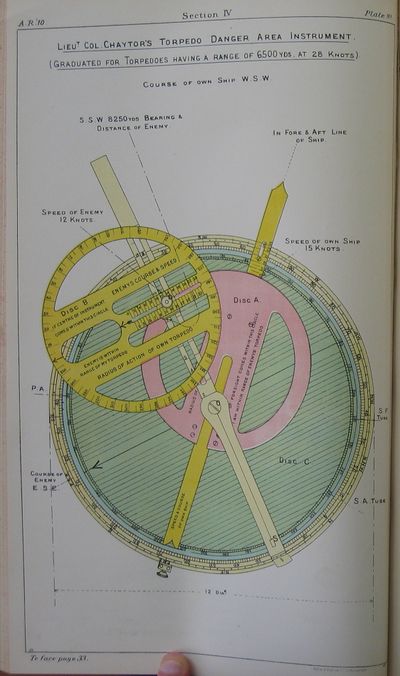Difference between revisions of "Chaytor's Torpedo Danger Area Instrument"
| Line 1: | Line 1: | ||
[[File:ARTS1910Plate10.jpg|thumb|400px|'''Mark III Dreyer Fire Control Table as it appeared by 1918, front'''<br>Bearing plot, deflection drums and deflection totaliser on left (Wind Dumaresq obscured behind this equipment), Mark VI* dumaresq with integral range and bearing clocks beneath gyro-compass repeater and Forbes log in centre, and range plot, gun range counter and spotting corrector on right. ]] | [[File:ARTS1910Plate10.jpg|thumb|400px|'''Mark III Dreyer Fire Control Table as it appeared by 1918, front'''<br>Bearing plot, deflection drums and deflection totaliser on left (Wind Dumaresq obscured behind this equipment), Mark VI* dumaresq with integral range and bearing clocks beneath gyro-compass repeater and Forbes log in centre, and range plot, gun range counter and spotting corrector on right. ]] | ||
| − | '''Chaytor's Torpedo Danger Area Instrument''' was a torpedo control device conceived by Lieutenant Colonel Chaytor. | + | '''Chaytor's Torpedo Danger Area Instrument''' was a torpedo control device conceived by Lieutenant Colonel Chaytor.{{ARTS1910|p. 33}} |
The device showed in a graphic manner the moment when your ship and that of an enemy would fall within range of each other's torpedoes. As it showed the geometry graphically, it offered ideas of how to maneuver to speed up or altogether avoid the moment of danger, or to gauge how truly dangerous it was. | The device showed in a graphic manner the moment when your ship and that of an enemy would fall within range of each other's torpedoes. As it showed the geometry graphically, it offered ideas of how to maneuver to speed up or altogether avoid the moment of danger, or to gauge how truly dangerous it was. | ||
| Line 15: | Line 15: | ||
==Development and Experience== | ==Development and Experience== | ||
| − | It was mentioned in 1909's Annual Report, along with a reportedly similar device proposed by Naval Instructor Veater. Both were to receive sea trials. | + | It was mentioned in 1909's Annual Report, along with a reportedly similar device proposed by Naval Instructor Veater. Both were to receive sea trials.{{ARTS1909|p. 22}} The drawing in the 1910 Annual Report seems to imply Chaytor's device was completed, but your editor failed to photograph enough pages in ''The Annual Report of the Torpedo School, 1910'' to fully detail its function or results obtained.{{ARTS1910|p. 33}} |
{{TBC}} | {{TBC}} | ||
| Line 27: | Line 27: | ||
==Bibliography== | ==Bibliography== | ||
{{refbegin}} | {{refbegin}} | ||
| − | *{{ | + | *{{ARTS1909}} |
| − | *{{ | + | *{{ARTS1910}} |
{{refend}} | {{refend}} | ||
[[Category:Torpedo Control]] | [[Category:Torpedo Control]] | ||
[[Category:Shipboard Equipment]] | [[Category:Shipboard Equipment]] | ||
Revision as of 16:23, 24 July 2012

Bearing plot, deflection drums and deflection totaliser on left (Wind Dumaresq obscured behind this equipment), Mark VI* dumaresq with integral range and bearing clocks beneath gyro-compass repeater and Forbes log in centre, and range plot, gun range counter and spotting corrector on right.
Chaytor's Torpedo Danger Area Instrument was a torpedo control device conceived by Lieutenant Colonel Chaytor.[1]
The device showed in a graphic manner the moment when your ship and that of an enemy would fall within range of each other's torpedoes. As it showed the geometry graphically, it offered ideas of how to maneuver to speed up or altogether avoid the moment of danger, or to gauge how truly dangerous it was.
Function
The device was quite a bit like a Dumaresq, but was likely flatter. It had a pair of round discs of equal diameter whose diameter was proportional to the supposed (equal) range of the friendly and enemy torpedoes. You set the following inputs:
- Own speed and course (this arm was fixed along your keel line - you would rotate an outer ring to set your heading)
- Enemy's speed and course (as in a dumaresq, this assembly was carried on the own speed slider)
- Bearing and distance to enemy
- Range and speed of the torpedoes (both being assumed the same)
If the disc borne on the enemy slider covered the center of the device, the moment when torpedoes capable of reaching their target had arrived.
Development and Experience
It was mentioned in 1909's Annual Report, along with a reportedly similar device proposed by Naval Instructor Veater. Both were to receive sea trials.[2] The drawing in the 1910 Annual Report seems to imply Chaytor's device was completed, but your editor failed to photograph enough pages in The Annual Report of the Torpedo School, 1910 to fully detail its function or results obtained.[3]
[TO BE CONTINUED - TONE] — TONY LOVELL, Editor.
See Also
Footnotes
Bibliography
- H.M.S. Vernon. Annual Report of the Torpedo School, 1909, with Appendix (Wireless Telegraphy). Copy 7 at The National Archives. ADM 189/29.
- H.M.S. Vernon. Annual Report of the Torpedo School, 1910, with Appendix (Wireless Telegraphy). Copy 436 at The National Archives. ADM 189/30.